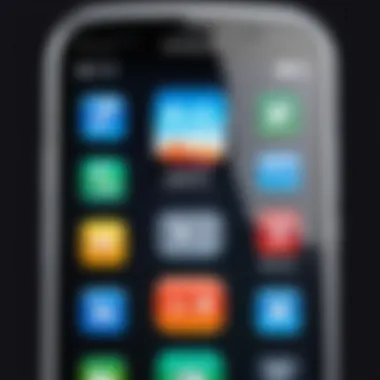Big Button Cell Phones for Seniors: A Complete Guide


Intro
As technology continues to evolve rapidly, it is essential to consider the unique needs of elderly users. The rise of big button cell phones serves as a testament to the potential for progress in making communication accessible for seniors. These phones often come with larger keys and simplified interfaces, aiming to increase usability for an aging population that may not be as comfortable with traditional smartphones.
This article will delve into various aspects of big button cell phones, including their features, design, and performance. By examining the factors influencing the selection of these devices, we can discern how they enhance communication and accessibility for seniors. Ultimately, this guide seeks to empower both seniors and their caregivers to make informed choices that align with individual needs.
The following sections will provide a detailed exploration of what these phones offer and how they compare in a competitive market.
Prologue to Big Button Cell Phones for Seniors
The importance of big button cell phones for seniors cannot be overstated. As the population ages, the demand for user-friendly technology increases. These devices address specific needs of older adults, making communication more accessible and less frustrating. The straightforward design allows seniors to navigate calls and messages with ease. It is not just a convenience; it enables seniors to stay connected with family and friends, enhancing their personal well-being.
Understanding the Need
As people age, they may experience challenges such as diminished eyesight, reduced dexterity, or cognitive decline. Traditional smartphones often offer more features than seniors require. They can be overwhelming and complex, creating barriers to effective use. Big button cell phones simplify the experience. They typically have fewer functions and focus on essential features, allowing seniors to make calls, send texts, and access emergency services without confusion. The focus on large buttons and clear displays caters to the physical and cognitive needs of older users.
Defining Big Button Cell Phones
Big button cell phones are specifically designed for easy use by seniors. They stand out because of their oversized buttons and simplified interfaces. These phones often lack the multitude of apps found on smartphones, which can distract or confuse users. Instead, they prioritize essential functions like dialing and emergency contacts. Many models come equipped with features like loudspeaker functionality and emergency buttons for immediate assistance. Overall, these phones combine simplicity with practicality, ensuring that seniors can communicate effectively without unnecessary complications.
Design Features of Big Button Cell Phones
The design aspects of big button cell phones hold significant weight in enhancing the user experience for seniors. These devices are not just simple phones; they are crafted to cater to the unique needs of older adults. Factors such as ease of use, visibility, and comfort are paramount in the design. Each feature integrates seamlessly to offer a practical solution, allowing seniors to communicate effectively without frustration or confusion. The focus is on creating a user-friendly interface that minimizes complexity. This section delves into three primary design features: large keypads, clear displays, and ergonomic considerations.
Large Keypads for Easy Navigation
Large keypads are one of the standout features of big button cell phones. The design of keypads challenges the traditional small keys found on standard mobile phones. A larger keypad allows for easier accessibility, especially for users who may have limited dexterity or visual impairments. The keys are designed to be spaced adequately apart, reducing the likelihood of pressing multiple buttons at once.
This feature can significantly enhance the user experience. It eliminates the frustration often associated with more compact designs. The tactile feedback from these buttons is also important. Users can feel when a key has been pressed, providing assurance that their intended action has been registered.
In summary, larger keypads contribute not only to ease of use but also promote confidence in handling the device.
Clear and Readable Displays
Another crucial aspect of big button cell phones is their clear and readable displays. As people age, they may experience diminishing eyesight, making it difficult to read small text. Big button cell phones address this through larger screens and bold font.
Displays are designed to maximize contrast, making it easier for seniors to read messages and navigate menus. Most devices incorporate adjustable settings, allowing users to increase font sizes or change background colors to suit their preferences. This adaptability is essential, as it recognizes the varying levels of visual acuity among elderly users.
Users can also benefit from simplified icons and straightforward layouts, reducing cognitive load. When navigating the phone, a clear display acts as a guiding tool, ensuring that users can find what they need without overwhelming complexity.


Ergonomic Considerations
Ergonomics plays a significant role in ensuring that big button cell phones are comfortable to use over extended periods. Devices are often designed with weight distribution in mind, making them easy to grasp without straining the hand. The shape of the phone can also affect how it feels when held. Rounded edges or contoured designs often provide a better fit for senior users.
Additionally, many models prioritize lightweight materials, reducing fatigue during prolonged use. This attention to ergonomic details is crucial for seniors who may have conditions such as arthritis or weakened grip strength.
This comprehensive look at design features illustrates that big button cell phones are tailored to meet the needs of seniors effectively. Each feature is not merely about aesthetics but serves a functional purpose that collectively enhances communication and fosters independence.
Key Functionalities for Seniors
When looking at big button cell phones, it is essential to understand the key functionalities that truly cater to seniors. These functionalities are crucial for ensuring that the devices are not just easy to use, but also provide peace of mind and improve daily communication. Each of these features plays an important role in making the technology user-friendly for older adults and enhancing their overall experience.
Emergency Features
Emergency features are perhaps the most critical component in a big button cell phone for seniors. Many models come with a dedicated emergency button. This button enables users to contact emergency services or family members quickly and easily. In some cases, these buttons can be customized to call a specific contact with a single push. This can significantly alleviate worries about safety for seniors and their families.
Additionally, some phones include GPS tracking capabilities. This feature can be particularly beneficial for seniors who may wander or find themselves in unfamiliar places. Family members can locate the phone through a connected app or service, offering peace of mind. This dual capability of emergency calling and GPS creates a safety net that many elderly users find reassuring.
Voice Assistants and Accessibility Options
Voice assistants have transformed how people interact with devices, making them particularly beneficial for seniors. Many big button cell phones now come equipped with voice activation technology. This allows users to make calls, send texts, or even access information without needing to navigate complex menus. The ability to speak commands can reduce frustration and confusion, creating a smoother experience for elderly users.
Moreover, accessibility options are vital for those who may have difficulties with vision or dexterity. Features such as text-to-speech, screen magnification, and adjustable text sizes ensure that seniors can use the phone comfortably. These options allow seniors to personalize their devices according to their individual needs, enhancing overall usability. Implementing these functionalities can significantly increase independence and confidence when using technology.
Battery Life and Efficiency
When selecting a phone for seniors, battery life must not be overlooked. Many big button cell phones prioritize long battery life to ensure that seniors can stay connected throughout the day. Options that offer extended usage before needing a recharge provide a significant advantage. Little concerns about frequent charging can help seniors maintain their routines without disruption.
Furthermore, battery efficiency can influence overall device performance. Phones that smartly manage battery consumption are more appealing as they often prolong device life. This focus on efficiency aligns with the expectations of seniors who may prefer low-maintenance technology. Offering a phone that balances performance with energy efficiency can greatly enhance user satisfaction.
Evaluating Popular Models
Evaluating popular models of big button cell phones is essential. This process helps seniors select a device that meets their specific needs. Each phone offers distinct features and functionalities. Therefore, understanding these can significantly enhance the communication experience for elderly users.
Top Choices in the Market
In the market, several big button cell phone models stand out for seniors. The Nokia 3310 is one such choice. Its robust build and intuitive interface make it suitable for everyday use. Another option is the Jitterbug Flip, known for its large buttons and emergency features. Additionally, the Samsung Galaxy Jitterbug smartphone caters to seniors wanting more advanced functionality, with applications designed for easier navigation.
These phones are not only user-friendly but also provide essential communication tools that seniors often require.
Comparative Analysis of Features


When choosing a big button cell phone, analyzing features is critical. A direct comparison helps users identify which phone best suits their requirements.
- Ease of Use: Jitterbug Flip's design includes large numbers and a clear menu. This feature is vital for seniors who may struggle with smaller buttons.
- Emergency Features: The Jitterbug models have an emergency button that connects directly to emergency services. This provides peace of mind.
- Display Clarity: The Nokia 3310 features a bright display, which is beneficial in various lighting conditions, making it easier for seniors to read texts.
- Battery Life: Battery longevity is crucial. Models like the Nokia 3310 can last several days without charging, which is advantageous for users who may forget to charge their phones regularly.
Customer Reviews and Feedback
Examining customer reviews is a valuable step in the evaluation process. Reviews provide insights into real-life experiences from fellow seniors. Many Jitterbug Flip users praise its straightforward interface. On the other hand, some users of the Samsung Galaxy experience a learning curve due to its smartphone nature. It is essential to read both positive and negative feedback to get a balanced view.
"I chose the Jitterbug for its ease of use and excellent customer service. It has transformed how I communicate with family."
— A Jitterbug user.
This reflection illustrates how important user-friendly designs are for seniors. Ultimately, gathering information from various sources will help individuals make informed choices when selecting the right big button cell phone.
Considerations When Choosing a Cell Phone
Selecting the right cell phone for seniors involves careful deliberation over multiple factors. Not only does it encompass the technical specifications of the device, but it also addresses personal needs and comfort levels. This section aims to provide insights on what to prioritize, ensuring that users can make informed choices that enhance their communication experience.
Personal Preferences and Usage Habits
When choosing a cell phone, understanding individual preferences is essential. Seniors often require a device that aligns with their usage habits. For instance, some may prioritize simplicity and ease of use, while others might appreciate additional features like internet access or apps.
- User Interface: Look for a model with an intuitive interface. A system that is straightforward can reduce frustration.
- Call Features: Many seniors primarily use their phones for calling. Therefore, a model with clear audio and easy dialing is ideal.
- Texting Capacities: If a senior enjoys sending texts, a larger keypad can facilitate easier typing.
Adapting the choice to the user's preferences leads to increased satisfaction and greater likelihood of regular use.
Budgeting for Purchase
Budget plays a crucial role in the selection process. Knowing how much to invest in a phone can narrow down choices significantly. While there are many options available, a common misconception is that the most expensive models are the best.
- Price Range: Determine a realistic budget. Many reliable big button cell phones are available without breaking the bank.
- Hidden Costs: Consider any additional costs such as service plans or accessories. Some companies may provide discounts for seniors.
- Longevity vs. Price: Sometimes, it makes sense to spend a little more for a device that will last longer and require fewer replacements over time.
Setting a budget aids in eliminating distractions while browsing and keeps the process focused on practical choices.
Support and Warranty Options
Support and warranty should not be overlooked when selecting a device. A good warranty can offer peace of mind, especially for technology that may be unfamiliar to some seniors.
- Customer Support: Check if the model comes with reliable customer service. A responsive helpline can be invaluable should issues arise.
- Warranty Terms: Review the warranty options. Longer warranties or coverage for accidental damages can save money in the long run.
- User Guides and Resources: Accessibility to clear user manuals or online resources can help seniors adapt better to their devices. Online communities like Reddit can also provide helpful peer support.
In summary, technology should cater to the user's needs rather than complicating their life. Considering personal preferences, budgeting effectively, and ensuring adequate support are all fundamental steps toward finding the right big button cell phone for seniors.


The Role of Technology in Senior Communication
Technology plays a critical role in enhancing communication for seniors. It bridges the gap between generations, allowing the elderly to stay connected with their families and friends. The introduction of devices with big buttons, like specialized cell phones, caters specifically to the needs of older users. Such technology not only provides ease of access but also promotes independence and improves their overall quality of life.
One primary benefit of technology for seniors is social connectivity. As people age, they risk becoming isolated. Easy-to-use devices offer a pathway for seniors to remain engaged with their loved ones. This connectivity is essential for mental health and well-being.
Impact on Social Connectivity
Social connections are vital for a senior’s mental and emotional health. Technology, especially mobile phones with big buttons, enables seniors to communicate more effectively without the frustration often associated with complex devices. Research indicates that maintaining social ties can significantly reduce feelings of loneliness and depression among the elderly.
With big-button cell phones, seniors can easily make calls, send text messages, and even access social media platforms like Facebook. These phones often include features such as:
- One-touch dialing for emergency contacts
- Voice messaging capabilities
- Photo-sharing options for keeping in touch with family
These features help seniors feel more in control of their communication, leading to more frequent interactions with friends and family.
Adapting to Technology as Seniors Age
As technology continues to evolve, many seniors face challenges when adapting to new devices. However, offering simple solutions like big button cell phones can facilitate a smoother transition. It is crucial for manufacturers to prioritize usability in their designs, ensuring that seniors do not feel overwhelmed.
Education and support also play a significant role. Family members can assist in teaching seniors how to use their new devices, guiding them through basic functions. Tracking changes and new innovations is necessary to ensure seniors keep up with advancements in technology. Providing resources like tutorials or in-person sessions can greatly enhance this learning process.
Ultimately, adapting technology to meet seniors' needs enriches their lives. It opens new avenues for them to explore, stay connected, and remain active participants in today's digital society.
"The integration of technology in daily life is essential for seniors not only to enhance communication but also to promote a sense of belonging and purpose."
In summary, technology serves as a lifeline for seniors. It addresses their unique challenges while providing solutions that foster connectivity and independence.
Final Thoughts
Choosing the right big button cell phone for seniors is not a trivial task. This decision impacts their daily communication, emergency accessibility, and overall interaction with technology. Through this guide, we have explored various critical aspects: from design features that cater to older adults to the vital functionalities that ensure safety and convenience.
In summary, big button cell phones are specifically engineered to meet the needs of seniors. Their large keypads, clear displays, and essential emergency features simplify technology use. Additionally, the role of technology in enhancing social connectivity for seniors cannot be understated. With proper communication tools, seniors can maintain relationships and feel included in their social environments.
As we discussed, the selection of a device goes beyond just features; personal preferences, intended use, and budget constraints must also be considered. It is important for caretakers and seniors alike to reflect on these elements, ensuring that their choice aligns with their lifestyle and needs.
"Technology is best when it brings people together." - Matt Mullenweg
Summarizing Key Takeaways
- Focus on Usability: Simplicity in the design is crucial. Devices should be easy to operate.
- Emergency Features: Look for phones with quick access to help when needed.
- Battery Life: Long battery life is a significant component for uninterrupted communication.
- Accessibility Options: Voice assist and other features improve usability for seniors with disabilities.
- Model Variability: Not all phones serve the same purpose. Evaluate carefully according to individual needs.
Encouragement for Informed Choices
Seniors and their families should gather information before making a purchase. Researching different models and understanding the specific needs of the user can lead to better decisions. Daunting as the task may seem, utilizing resources such as reviews, comparison guides, and discussions in forums like Reddit can yield insights that help in making an informed choice. Seek guidance from experts or tech-savvy friends when necessary. Considering factors like warranty options can also provide peace of mind in the purchase process.
Ultimately, the goal is to enhance communication and support a fulfilling life. Therefore, investing time in the selection process will certainly benefit seniors significantly.



